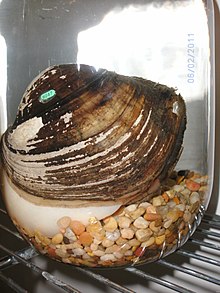Lampsilis cardium: Difference between revisions
Appearance
Content deleted Content added
Pvmoutside (talk | contribs) |
m Task 19: convert/update IUCN references to {{cite iucn}} using data from IUCN Red List API; IUCN status confirmed; IUCN status ref updated; (2/00:03.57); |
||
| (6 intermediate revisions by 5 users not shown) | |||
| Line 1: | Line 1: | ||
{{Short description|Species of bivalve}} |
|||
{{Italic title}} |
|||
{{Speciesbox |
|||
{{Taxobox |
|||
| name = ''Lampsilis cardium'' |
|||
| image = Lampsilis cardium.jpg |
| image = Lampsilis cardium.jpg |
||
| status = |
| status = LC |
||
| status_system = IUCN3.1 |
|||
| status_ref =<ref name="iucn status 17 November 2021">{{cite iucn |author=Bogan, A.E. |author2=Seddon, M.B. |author3=Woolnough, D. |date=2017 |title=''Lampsilis cardium'' |volume=2017 |page=e.T11253A62905411 |doi=10.2305/IUCN.UK.2017-3.RLTS.T11253A62905411.en |access-date=17 November 2021}}</ref> |
|||
| regnum = [[Animalia]] |
|||
| |
| genus = Lampsilis |
||
| |
| species = cardium |
||
| ⚫ | |||
| ordo = [[Unionoida]] |
|||
| familia = [[Unionidae]] |
|||
| genus = ''[[Lampsilis]]'' |
|||
| species = '''''L. cardium''''' |
|||
| binomial = ''Lampsilis cardium'' |
|||
| ⚫ | |||
| synonyms = |
| synonyms = |
||
}} |
}} |
||
| Line 19: | Line 14: | ||
==Reproduction== |
==Reproduction== |
||
All Unionidae are known to use the gills, fins, or skin of a host fish for nutrients during the larval glochidia stage. ''Lampsilis cardium'' accomplishes this by having the inner sides of its mantle flaps marked with longitudinal stripes, resembling a small fish of the genus ''[[Notropis]]''. When these are attacked and ruptured by a striking predator fish, especially ''[[Micropterus coosae]]'', the mussel larva is released into the gills of the host fish where it feeds and develops.<ref name=unio/><ref>{{cite journal|journal=Freshwater Biology| year=1999| volume=42| pages=35–40| title=Mantle displays of freshwater mussels elicit attacks from fish| author1=Haag, Wendell R.| author2= Warren Jr., Melvin L.}}</ref> |
All Unionidae are known to use the gills, fins, or skin of a host fish for nutrients during the larval glochidia stage. ''Lampsilis cardium'' accomplishes this by having the inner sides of its mantle flaps marked with longitudinal stripes, resembling a small fish of the genus ''[[Notropis]]''. When these are attacked and ruptured by a striking predator fish, especially ''[[Micropterus coosae]]'', the mussel larva is released into the gills of the host fish where it feeds and develops.<ref name=unio/><ref>{{cite journal|journal=Freshwater Biology| year=1999| volume=42| pages=35–40| title=Mantle displays of freshwater mussels elicit attacks from fish| author1=Haag, Wendell R.| author2= Warren Jr., Melvin L.| doi=10.1046/j.1365-2427.1999.00454.x}}</ref> |
||
==References== |
==References== |
||
{{Reflist}} |
{{Reflist}} |
||
==External links== |
|||
*Bogan, A. E. 1996. [http://www.iucnredlist.org/details/11253/0 ''Lampsilis cardium''.] In: IUCN 2013. IUCN Red List of Threatened Species. Version 2013.2. Downloaded on 26 December 2013. |
|||
{{Taxonbar|from=Q3013322}} |
{{Taxonbar|from=Q3013322}} |
||
[[Category:Molluscs of the United States]] |
[[Category:Molluscs of the United States]] |
||
[[Category:Lampsilis]] |
[[Category:Lampsilis|cardium]] |
||
[[Category:Bivalves described in 1820]] |
[[Category:Bivalves described in 1820]] |
||
[[Category:Taxa named by Constantine Samuel Rafinesque]] |
|||
[[Category:Taxonomy articles created by Polbot]] |
[[Category:Taxonomy articles created by Polbot]] |
||
Latest revision as of 15:19, 17 November 2021
| Lampsilis cardium | |
|---|---|

| |
| Scientific classification | |
| Domain: | Eukaryota |
| Kingdom: | Animalia |
| Phylum: | Mollusca |
| Class: | Bivalvia |
| Order: | Unionida |
| Family: | Unionidae |
| Genus: | Lampsilis |
| Species: | L. cardium
|
| Binomial name | |
| Lampsilis cardium Rafinesque, 1820
| |
Lampsilis cardium is a species of freshwater mussel in the family Unionidae, the river mussels. It is known commonly as the plain pocketbook.[2] It is widespread in eastern North America, where it is native to the Mississippi River and Great Lakes drainage systems.
Reproduction
[edit]All Unionidae are known to use the gills, fins, or skin of a host fish for nutrients during the larval glochidia stage. Lampsilis cardium accomplishes this by having the inner sides of its mantle flaps marked with longitudinal stripes, resembling a small fish of the genus Notropis. When these are attacked and ruptured by a striking predator fish, especially Micropterus coosae, the mussel larva is released into the gills of the host fish where it feeds and develops.[2][3]
References
[edit]- ^ Bogan, A.E.; Seddon, M.B.; Woolnough, D. (2017). "Lampsilis cardium". IUCN Red List of Threatened Species. 2017: e.T11253A62905411. doi:10.2305/IUCN.UK.2017-3.RLTS.T11253A62905411.en. Retrieved 17 November 2021.
- ^ a b Plain pocketbook, Lampsilis cardium. Unio Gallery. Missouri State University.
- ^ Haag, Wendell R.; Warren Jr., Melvin L. (1999). "Mantle displays of freshwater mussels elicit attacks from fish". Freshwater Biology. 42: 35–40. doi:10.1046/j.1365-2427.1999.00454.x.

